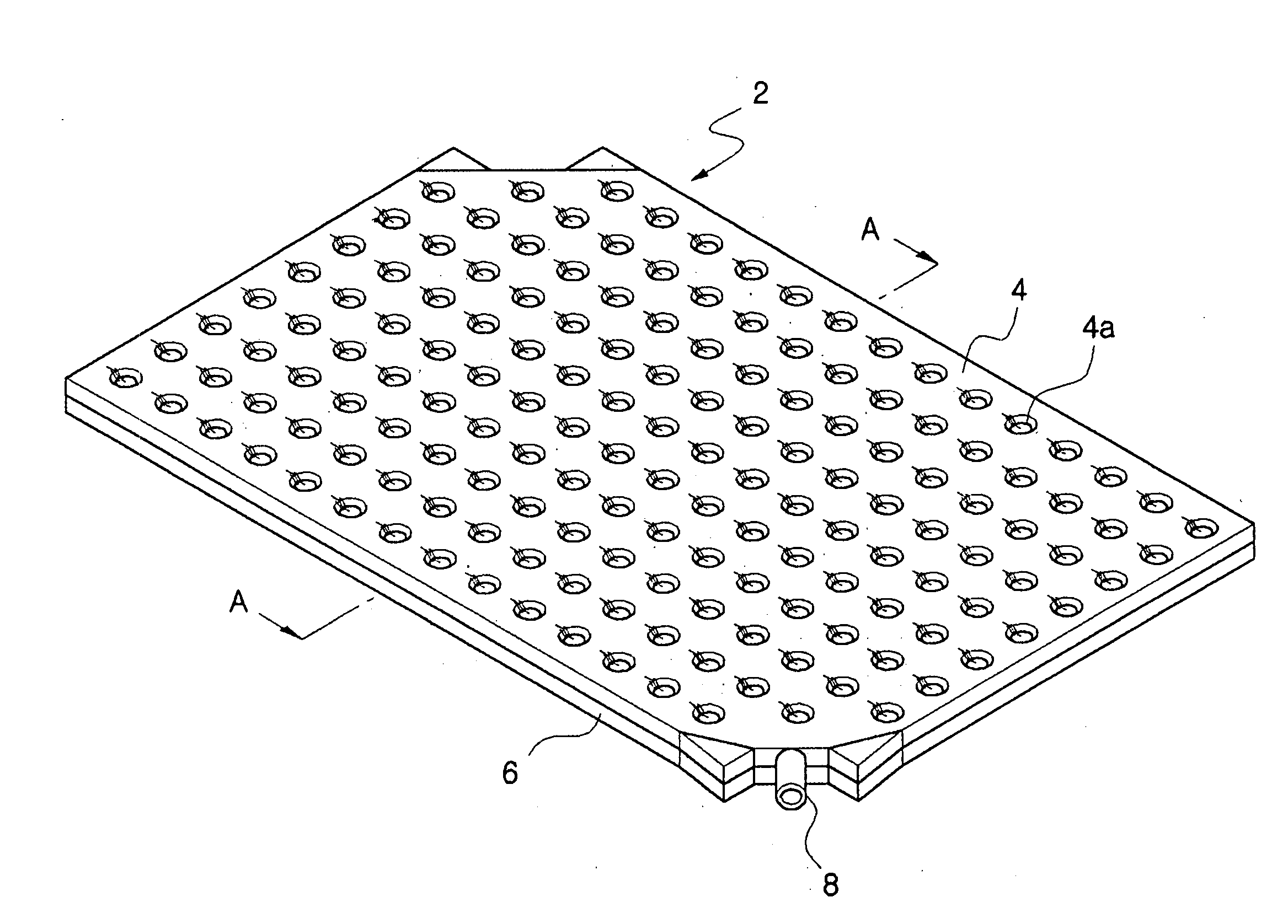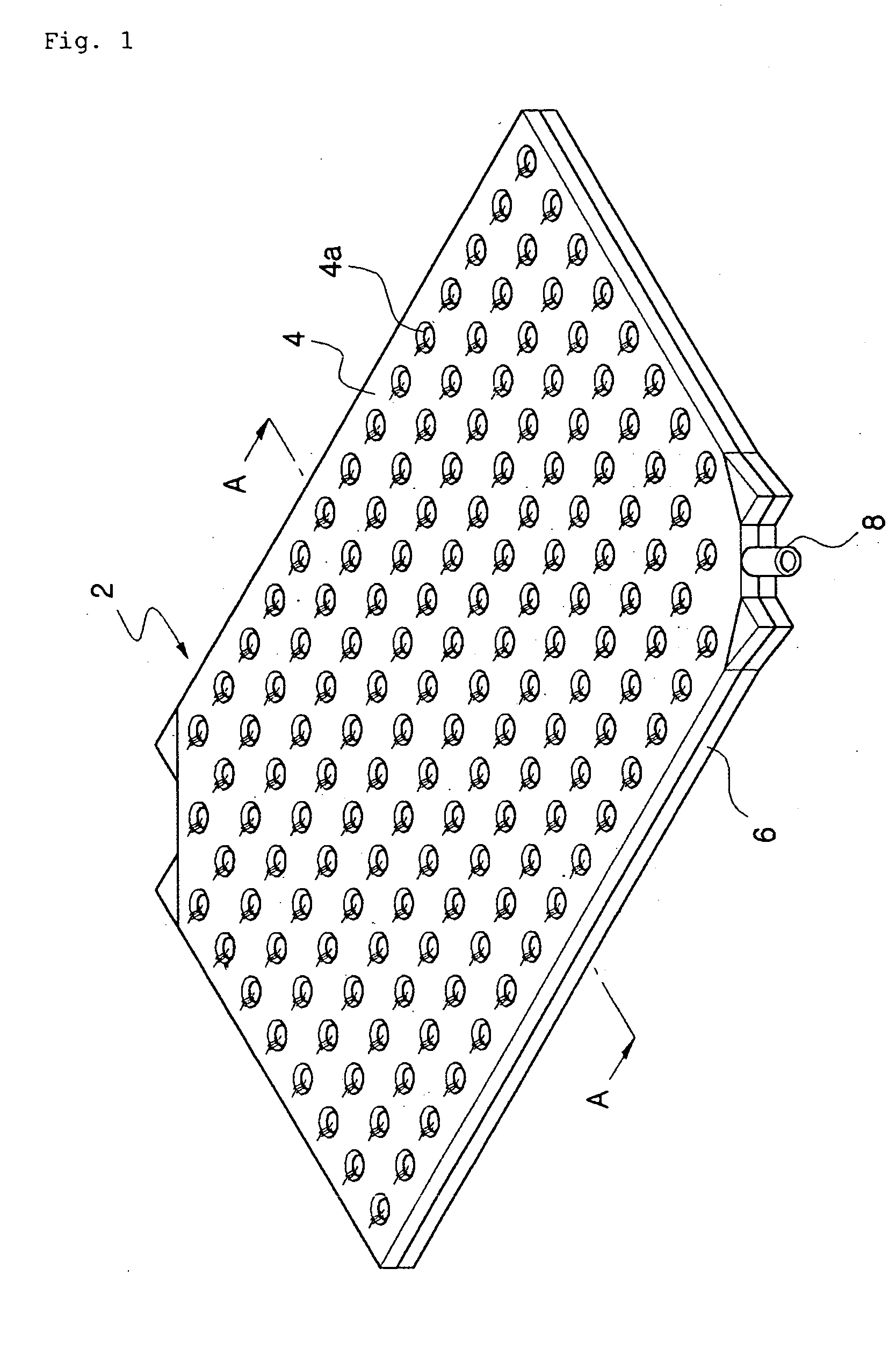[0005] In order to solve the problems of the conventional wet heating system as described above, a
dry heating panel, made of concrete, a
synthetic resin or yellow clay, was developed. The dry heating panel has a pipe for carrying heating water embedded therein or is provided with grooves or fixing members for inserting the pipe for carrying heating water. The dry heating panel is an assembled heating panel, and has advantageous effects in that the construction of the heating system may be completed by simply assembling previously produced pieces of the dry heating panel, thereby reducing the construction time, and simplifying maintenance and overhaul operations thereof. However, the dry heating panel has problems in that, since it adopts a
line heating structure in which
radiation heat is mainly concentrated where the pipe for carrying heating water is located, generating a severe temperature variation in the heating system, the dry heating panel is ineffective in view of heating efficiency, and in that, since the pipe itself is made of
metal or a
synthetic resin, it is expensive, resulting in increased construction costs. Furthermore, thermal loss may occur due to
piping, and dewing may occur on the surface of the pipe, thereby
wetting the panel.
[0006] In order to solve the problems of the conventional dry heating panel described above, as disclosed in U.S. Pat. No. 5,080,166 and Korean
patent application Laid-open publication No. 2002-95733, a plate-shaped heating panel provided with an inner fluid pathway for allowing the heating water to flow therethrough was developed. Compared with the dry type heating system adopting the
line heating structure, the plate-shaped heating panel having the inner fluid pathway therein adopts a plane heating structure in which the heating water flows not in a local area but in an overall area of panels, so that it provides very high heating efficiency, resulting in reduction of fuel expenses, and so that the pipe is not required for the structure of the plate-shaped heating panel, thereby eliminating a complicated
piping work and reducing the expenses for piping. Additionally, the plate-shaped heating panel is not subjected to the thermal loss and dewing, which usually occur on the surface of the pipe in the structure of the dry heating panel, and allows the weight of the panel to be reduced. Furthermore, the plate-shaped heating panel is very easy to construct and repair.
[0007] Conventionally, the plate-shaped heating panel with an inner fluid pathway formed therein was formed by way of
blow molding, as also known as hollow molding. The
blow molding is a molding method which forms a hollow product by blowing air into a separating mold, in which molten
thermoplastic forming material is inserted and then softened with heat.
[0008] Conventionally, upon manufacturing the plate-shaped heating panel by way of the
blow molding, a
thermoplastic resin is pushed in an
extrusion die, and hot air is blown into the resin, forming a cylindrical-shaped resin. Then, the resin is compressed by molds at both sides, thereby forming a heating panel with an inner fluid pathway formed therein.
[0009] The inner fluid pathway adjacent to an inlet or an outlet of the heating panel produced as described above is thinned due to a strong pressure of the hot air, and an angle of a notch (which is an edge submerging a small angle between symmetrical lines) is further decreased, causing stress to concentrate on the notch, resulting in reduction of the pressure resistance of the heating panel.
[0010] Accordingly, in the case where heating water of a predetermined pressure is passed through the heating panel, such a
stress concentration around the inlet and outlet can form a crack around the inlet or the outlet, leading to damage of the inlet and outlet of the heating panel, and separation of connecting members of the heating panel. If any part of the heating panel is damaged, the separation of the connecting member affects the entire heating panel, resulting in separation of the heating panel.
 Login to View More
Login to View More 


